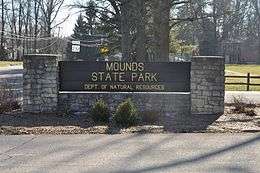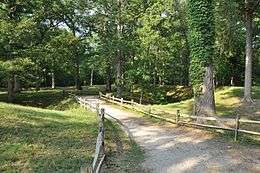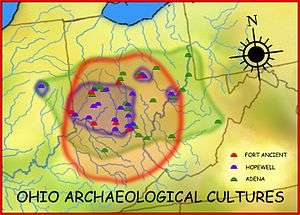Mounds State Park
Mounds State Park is a state park near Anderson, Madison County, Indiana featuring Native American heritage, and ten ceremonial mounds built by the prehistoric Adena culture indigenous peoples of eastern North America, and also used centuries later by Hopewell culture inhabitants. It is separate from (and about 79 miles northwest of) the similarly-named Mounds State Recreation Area (near Brookville, Franklin County, Indiana).
 Mounds State Park entrance sign. | |
 Site of park in U.S. state of Indiana | |
| Location | Anderson, Indiana, Madison County, Indiana, |
|---|---|
| Region | Madison County, Indiana |
| Coordinates | 40°6′1.39″N 85°37′14.60″W |
| History | |
| Founded | 160 BCE |
| Cultures | Adena culture, Hopewell tradition |
| Site notes | |
| Architecture | |
| Architectural styles | earthworks |
| Architectural details | Number of monuments: 10 |
Mounds State Park | |
| Area | 251.8 acres (101.9 ha) |
| NRHP reference No. | 73000022[1] |
| Added to NRHP | January 18, 1973 |
| Responsible body: Indiana Department of Natural Resources | |
Mounds

The largest earthwork, the "Great Mound", is believed to have been constructed around 160 BCE. The Great Mound is a circular earth enclosure with an internal ditch and south to southwest entrance. The earthworks measure 394 feet (120.1 m) across from bank to bank. The 9-foot-tall (3 m) embankment is 63 feet (19 m) wide at its base, and the ditch is 10.5 feet (3.2 m) deep and 60 feet (18.3 m) across at its top. The central platform is 138 feet (42 m) across and was occupied by a 4-foot-high (1.2 m) central mound 30 feet (9 m) in diameter. One particular mound at the Anderson Site has a sequence of clay platforms, each deliberately covered by a layer of ash.[2]
Earthworks
The term Earthworks includes any structure made from the earth. In Native American studies, there are three primary types: mounds, circular enclosures, and complexes. All are found in Central Indiana and in the state park.[3] Mounds State Park has a complex of enclosures, both circular and rectangular. There are seven enclosures and four additional earthworks, which have been divided into two groups, the northern complex and the southern complex. The ‘’Great Mound" enclosure is the dominant structure in the park and the southern group.[3]
Great Mound
The Great Mound is approximately 300 feet (91 m) across and consists of an outer embankment 9 feet (2.7 m) high and 63 feet (19 m) wide, surrounding a 60 feet (18 m) wide ditch that is 10.5 feet (3.2 m) deep. The central platform, 138 feet (42 m) is diameter with a central mound, 4 feet (1.2 m) high and 30 metres (98 ft) in diameter.[3] The central mound was excavated in 1968/69 and found to have three clay layers, each with ashes, showing a succession of use periods.[3]
The complex has been dated to 160 BCE through 50 CE These dates are obtained through radiocarbon dating and some artifacts.[3] A nearby log tomb was found with a platform pipe typical of Hopewell styles from 50 C.E. Post hole remnants were dated to 60 BCE and 230 CE. Radiocarbon dates from excavated material of the Great Mound established 160 BCE +/- 90 for the embankment. The neighboring ‘’Fiddleback" Mound was dated to 120 BCE +/- 70.[3]
Popular culture

In 1900, a series of strange misshapen skeletons were unearthed from similar mounds in nearby Alexandria, Indiana. This brought thousands of tourists from around the Mid-West. In 1910, several locals admitted to stealing chimpanzee skeletons from the nearby Muncie Zoo's monkey house. In 1915 the skeletons were sold to a local museum which burned down in 1919.[4]
What is now Mounds State Park was the location of an amusement park that operated from 1897 until 1929. While the amusement park exploited the native-made mounds, it also helped to protect them by making them a "point of regional pride and a destination"; otherwise they might have been plundered or otherwise destroyed. When the Great Depression hit, the property was sold to the Madison County Historical Society, which transferred ownership to the State of Indiana, after which it became Mounds State Park.[5]
Canoeing is also available in Mounds State Park, on the White River.
See also
- Adena culture
- Hopewell tradition
- List of Hopewell sites
- List of burial mounds in the United States
- List of archaeological sites on the National Register of Historic Places in Indiana
- List of Indiana state parks
References
- "National Register Information System". National Register of Historic Places. National Park Service. July 9, 2010.
- Dean R. Snow (2010). Archaeology of Native North America. New York: Prentice-Hall. p. 103.
- "Adena and Hopewell Cosmology: New Evidence from East Central Indiana; Donald R. Cochran; Native American Cultures in Indiana, ‘’Proceedings of the First Minnestrista Council for Great Lakes Native American Studies"; Ronald Hicks (ed.); Minnestrista Cultural Center; Muncie, Indiana; 1992; pgs 26-42
- Werner, Nicholas (1937). Mysterious Circumstances Of Central Indiana. Clayton Books. p. 121.
- "Mounds state Park Interpretive Master Plan 2011" (PDF). Indiana Department of Natural Resources. Retrieved 5 July 2012.
External links
| Wikimedia Commons has media related to Mounds State Park. |




